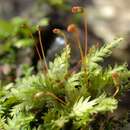Comments
provided by eFloras
Fissidens bryoides is a veritable kaleidoscope of intergrading expressions. At one extreme is F. bryoides in the strict sense, with plants gonioautoicous and the limbidium, 1-3 cells thick, confluent at the leaf apex with the percurrent to short-excurrent costa. At the other extreme is the expression that has been singled out as F. exiguus, with plants rhizautoicous and the 1-stratose limbidium usually restricted to the vaginant laminae of perichaetial leaves. In rare cases the limbidium can be absent from all leaves. All expressions, however, have clear, distinct, 1-stratose, irregularly hexagonal laminal cells, 6.5-16 µm, that in transverse section are no deeper than wide, and that have smooth walls that can be slightly bulging. H. A. Crum and L. E. Anderson (1981) illustrated the major expressions found in the flora area. Axillary, multicellular gemmae have been reported in Indian specimens.
- license
- cc-by-nc-sa-3.0
- copyright
- Missouri Botanical Garden, 4344 Shaw Boulevard, St. Louis, MO, 63110 USA
Description
provided by eFloras
The Fissidens bryoides complex is very variable. Five varieties of Fissidens bryoides have been reported from China. It is quite difficult to identify these varieties, especially when only vegetative plants are present since the classification of the complex is mainly based on the sexuality and distribution of gametangia rather than on the types of limbidia (Iwatsuki & Suzuki 1982).
- license
- cc-by-nc-sa-3.0
- copyright
- Missouri Botanical Garden, 4344 Shaw Boulevard, St. Louis, MO, 63110 USA
Description
provided by eFloras
Plants 3-11 × 0.9-3.2 mm. Stem unbranched and branched; axillary hyaline nodules absent; central strand usually present. Leaves as many as 20 pairs, lanceolate to oblong-lanceolate or oblong-lingulate, acute to short-acuminate or obtuse-apiculate, to 0.8-2.7 × 0.2-0.5 mm; dorsal lamina narrowed proximally, ending at or before insertion, infrequently slightly decurrent; vaginant laminae 1/2 leaf length, mostly equal; margin entire but often serrulate distally, limbate on all laminae, limbidium reaching apex or ending a few cells before or partially absent to infrequently completely absent, limbidial cells 1-3-stratose; costa excurrent to ending as many as 6 cells before apex, bryoides-type; laminal cells 1-stratose, distinct, smooth, often slightly bulging, firm-walled, irregularly hexagonal, a few elongate, 6.5-16 µm, somewhat larger in proximal parts of vaginant laminae. Sexual condition polyoicous; naked antheridia and archegonia often in axils of distal leaves. Sporophytes 1-2 per perichaetium. Seta 1.4-10 mm. Capsule theca exserted, erect, radially symmetric to ± inclined, bilaterally symmetic, 0.2-1.2 mm; peristome bryoides-type; operculum 0.5 mm. Calyptra cucullate smooth, to 0.5 mm. Spores 10-20 µm.
- license
- cc-by-nc-sa-3.0
- copyright
- Missouri Botanical Garden, 4344 Shaw Boulevard, St. Louis, MO, 63110 USA
Synonym
provided by eFloras
Dicranum bryoides (Hedw.) Sw., Monthl. Rev. 34: 538. 1801. Schistophyllum bryoides (Hedw.) Lindb., Musci Scand. 13. 1879.
- license
- cc-by-nc-sa-3.0
- copyright
- Missouri Botanical Garden, 4344 Shaw Boulevard, St. Louis, MO, 63110 USA
Synonym
provided by eFloras
Fissidens andersonii Grout; F. bryoides var. incurvus (Starke) Hübener; F. bryoides var. pusillus (Wilson) Pursell; F. exiguus Sullivant; F. exiguus var. falcatulus (Renauld & Cardot) Grout; F. pusillus (Wilson) Milde; F. synoicous Sullivant; F. texanus Lesquereux & James; F. viridulus (Swartz) Wahlenberg; F. viridulus var. pusillus Wilson; F. viridulus var. tamarindifolius (Turner) Grout; F. viridulus var. texanus (Lesquereux & James) Grout
- license
- cc-by-nc-sa-3.0
- copyright
- Missouri Botanical Garden, 4344 Shaw Boulevard, St. Louis, MO, 63110 USA
Comprehensive Description
provided by North American Flora
Fissidens bryoides Hedw. Sp Muse. 153. 1801
Fissidens synoicus Sull. Musci U. S. 103. 1856. Fissidens inconstans Schimp. Syn. ed. 2. 114. 1876.
Stems 5-25 mm. high; leaves few to many pairs, oblong, rather abruptly short-acuminate in typical forms, in others more obtuse and apiculate, the upper and perichaetial 1.5-2 mm. long, the border strong (especially on the vaginant laminae), typically confluent with the costa at the leaf-apex but often vanishing slightly below it, the vaginant laminae half the length of the leaf; leaf-cells variable in size and shape, mostly irregularly hexagonal, 8-12 /z, sometimes bulging; autoicous; cT buds in the lower leaf-axils; capsule typically erect and symmetric, sometimes inclined, the median exothecial cells mostly oblong with very thick longitudinal walls; spores in winter.
Type i^ocauty: Germany.
Distribution: Mostly on moist soil; Canada and the U. S. east of the Rockies, south to the Gulf; Vancouver I.; on limestone, in Deering Hammock near Miami, Fla.; Puerto Rico {Steere 6052, 6058, 5657); also in Europe.
I1.LUSTRAT10NS : Bryol. Eur. (17:) pi. 101 (as F. exilis); Braithw. Brit. Moss-Fl. 1: pi, 10, E.
- bibliographic citation
- Robert Statham Williams. 1943. (BRYALES); DICRANACEAE, LEUCOBRYACEAE. North American flora. vol 15(3). New York Botanical Garden, New York, NY

